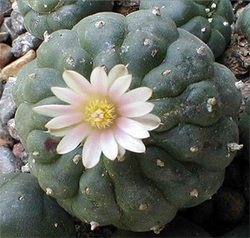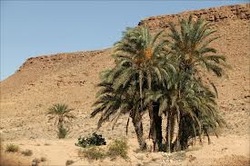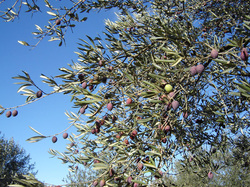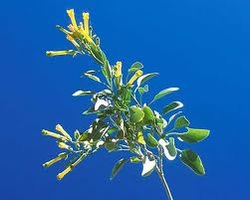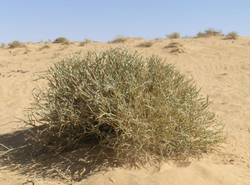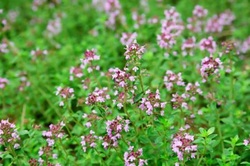Well as you can see in the others enterys of my blog, they have some special adaptations for the climate circunstances, they adapt to the place they are in an evolutive way as they need it.
So that`s the way animals and plants that live there figure it out how to survive.
Sahara Desert
lunes, 4 de septiembre de 2017
Plants in the sahara desert
There are various plants that grow in the Sahara Desert. Vegetation that grow in the Sahara must be able to adapt to unreliable precipitation and excessive heat. To survive they have made modification leaves into spines to prevent excessive loss of water from the plant body and deep roots to get to water source. Plants are more concentrated in oases and along river beds.
African Peyote Cactus thrives in the desert environment. Its thick stems retain water for long periods of time. Its spiny leaves help prevent water loss because of evaporation. Native Saharan tribes use peyote from this plant in their spiritual rituals. Every time it rains, the African peyote cactus collects water, storing it in their thick stem and until it rains again, that is all they survive on. It lives with very little sun and prefers soil with a PH of 6 or 7. The plant can be started from seeds or the shoots of an older plant.
Palm Trees mostly grow in areas where the water is closer to the surface. These types of trees are arranged in narrow lines and are oriented east to the west. The desert palm is found close to settlements where people dig wells to get water.
The Tobacco Tree (toxic) is native to South America, but has adapted to life in the desert. Flowers on this tree might be white, green, red, or yellow and they may open up at night. You may think the leaves of this tree are smokable, but that is incorrect. Poisoning leads to dizziness and altered vision. The Tobacco Tree can also lead to auditory hallucinations
Tamarisk (Shrub) grows up to 18 meters and thrives on saline or alkaline soil. It is often used for firewood, carpentry, and provides shade. Tamarisk can also serve as a windbreaker. It has small,scale like leaves and racemes of white, pink, or red flowers. Also, it has deep ranging roots and small, slender branches.
The ephedra alata is a dioecious shrub with richly-branched, erect stems. It has very short leaves and flowers with four to six anthers. The main activity of this plant is related to its alkaloids. Its plants can be used for a number of medicinal purposes.
The soil of the Sahara Desert is home to a drought-resistand herb called Thyme. Thyme is a major food source for the animals in the Sahara desert. Medicinally, the herb is used for treating indigestion, respiratory infections, and spasms.
Animals of the Sahara
Thousands of years ago, the Sahara had enough water so that people and animals were able to survive on the edge of the desert. There is evidence that the area was able to sustain river animals such as crocodiles. Fossils of dinosaurs, including Afrovenator, Jobaria and Ouranosaurus, have also been discovered in the desert.
Prehistoric rock paintings also depict cattle, giraffes, elephants and lions that roamed a once-lush Sahara.
Today, there is little water or vegetation to sustain life in most part of the Sahara. Some exceptions include the Nile Valley, a few oases, and the northern highlands, where Mediterranean plants such as the olive tree are found to grow. The change occurred in about 1600 B.C., after shifts in the Earth's axis increased temperatures and decreased precipitation.
Camels, most often associated with the Sahara, were introduced to the desert around 200 A.D. Their advantages over the horses they replaced include soft feet that are aligned so that they can move quickly and easily through sand and their ability to go for up to 17 days without food or water.
Rodents, snakes and scorpions thrive in the desert environment. The desert is home to the deathstalker scorpion, which can be nearly 4 inches (10 cm) in length. Its dangerous venom contains large amounts of agitoxin and scyllatoxin.
Among the 40-plus species of rodents in the Sahara is the jerboa, related to the mouse, rat and squirrel. To keep cool, the jerboa burrows underneath the desert's sands to more humid soils.
The Addax nasomaculatus, also known as the screwhorn antelope, is the Sahara's largest indigenous mammal. It travels in small herds throughout the Western Sahara, Mauritania and Chad. Instead of drinking water, it sucks moisture from the desert grasses and bushes. Its oversized hooves make the addax adept at moving through the Sahara's loose sand.
Jackals and several types of hyenas are among the carnivores that roam the Sahara. Weighing less than 3 pounds (1.4 kg), the Mall Fennec Fox is another carnivore that makes its home in tunnels in the sand dunes during the day and comes out at night to prey on the rodents.
Climate and geography of the Sahara
The Sahara’s northeasterly winds can reach hurricane level and often give rise to sand storms and dust devils. Half of the Sahara receives less than an inch of rain per year, and the rest receives up to 4 inches (10 centimeters) per year. The infrequent rain is usually torrential.
The highest peak in the Sahara is the volcano Emi Koussi (11,204 feet or 3,415 meters) in the Tibesti Mountains in northern Chad. The desert’s other mountains and mountain ranges include the Aïr Mountains, Hoggar (Ahaggar) Mountains, Saharan Atlas, Tibesti Mountains, Adrar des Iforas and the Red Sea hills.
Many people imagine the Sahara as dotted with sand dunes, and the desert does have its share of ergs, which are large areas of shifting sand dunes, with some of some of them reaching 590 feet (180 meters). However, most of the Sahara is characterized as rocky hamada, a type of desert landscape that has very little sand and is made up of primarily barren, hard, rocky plateaus.
With the exception of the Nile River, the Sahara’s rivers and streams are irregular or seasonal. The Nile crosses the desert from its origins in central Africa to empty into the Mediterranean.
The central part of the Sahara has extremely limited vegetation. The northern and southern reaches of the desert, along with the highlands, have areas of sparse grassland and desert shrub, with trees and taller shrubs.
The sahara Desert
The Sahara is the world’s largest hot desert and one of the harshest environments on the planet. It is third largest desert overall after Antarctica and the Arctic, which are cold deserts.
At 3.6 million square miles (9.4 million square kilometers), the Sahara, which is Arabic for "The Great Desert," engulfs most of North Africa. The desert covers large sections of Algeria, Chad, Egypt, Libya, Mali, Mauritania, Morocco, Niger, Western Sahara, Sudan and Tunisia.
The Sahara is bordered by the Atlantic Ocean on the western edge, the Atlas Mountains and the Mediterranean Sea to the north, the Red Sea on the east, and the Sudan and the valley of the Niger River on the south. The Sahara is divided into western Sahara, the central Hoggar (Ahaggar) Mountains, the Tibesti Mountains, the Air Mountains, an area of desert mountains and high plateaus, Ténéré desert and the Libyan desert, which is the most arid region.
In the north, the Sahara reaches to the Mediterranean Sea in Egypt and portions of Libya. In Cyrenaica and the Maghreb, the Sahara experiences a more Mediterranean climate with a winter rainy season.
Major cities located in the Sahara include Cairo, Egypt; Tripoli, Libya; Nouakchott, the capital of Mauritania; Tamanrasset, Ouargla, Bechar, Hassi Messaoud, Ghardaia, and El Oued in Algeria; Timbuktu in Mali; Agadez in Niger; and Faya-Largeau in Chad.
Suscribirse a:
Comentarios (Atom)
